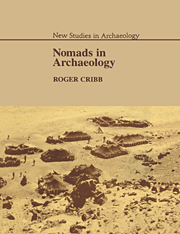Book contents
- Frontmatter
- Contents
- List of illustrations
- List of tables
- Preface
- 1 Introduction
- 2 Origins and definitions
- 3 Nomad pastoral economy
- 4 Residence, descent and territory
- 5 Nomads – the invisible culture?
- 6 Nomad architecture and domestic space
- 7 Ali's camp: a nomad household campsite
- 8 The structure and location of nomad settlements
- 9 Sariaydin Yayla
- 10 The lost world of Nemrut Daḡ
- 11 Nomad archaeology: an assessment
- 12 Towards a model of unstable settlement systems
- References
- Glossary
- Index
6 - Nomad architecture and domestic space
Published online by Cambridge University Press: 23 September 2009
- Frontmatter
- Contents
- List of illustrations
- List of tables
- Preface
- 1 Introduction
- 2 Origins and definitions
- 3 Nomad pastoral economy
- 4 Residence, descent and territory
- 5 Nomads – the invisible culture?
- 6 Nomad architecture and domestic space
- 7 Ali's camp: a nomad household campsite
- 8 The structure and location of nomad settlements
- 9 Sariaydin Yayla
- 10 The lost world of Nemrut Daḡ
- 11 Nomad archaeology: an assessment
- 12 Towards a model of unstable settlement systems
- References
- Glossary
- Index
Summary
As I approached Ali's winter camp all illusions about the simplicity of my task began to crumble. The tent – if it could be called that – was fashioned out of a mixture of rough limestone boulders and dressed blocks from a nearby Byzantine complex (Fig. 6.1). Its walls were nearly 1.5 metres high, and it was entered via a short passageway and a rickety wooden gate held by lengths of twisted wire. The structure was surmounted by wooden beams and a mixture of tentcloth; straw and polythene plastic. The interior of the dwelling contained the now-familiar array of rug-covered platforms though its proportions were less elongated than the norm. In the front wall, adjacent to the doorway, was a recessed fireplace beautifully constructed out of Byzantine building rubble and capped by a large limestone block covered by floral bas-reliefs. In summer Ali would be up in the Taurus Mountains living in a black tent with only the barest of stone footings. The following year at about the same time (early September) I found him camped some 200 metres away in a small beige-coloured tent whose interior was almost identical to that observed in the previous winter, but which was devoid of any foundation other than a cleared earth floor and a small hearth consisting of three stones.
The term nomad architecture may appear to contain an inherent contradiction. In fact there is a sizeable literature on the subject (Fagre 1979; Andrews 1981; Ferdinand 1959–60; Feilberg 1944; Edelberg 1966–67.)
- Type
- Chapter
- Information
- Nomads in Archaeology , pp. 84 - 112Publisher: Cambridge University PressPrint publication year: 1991



